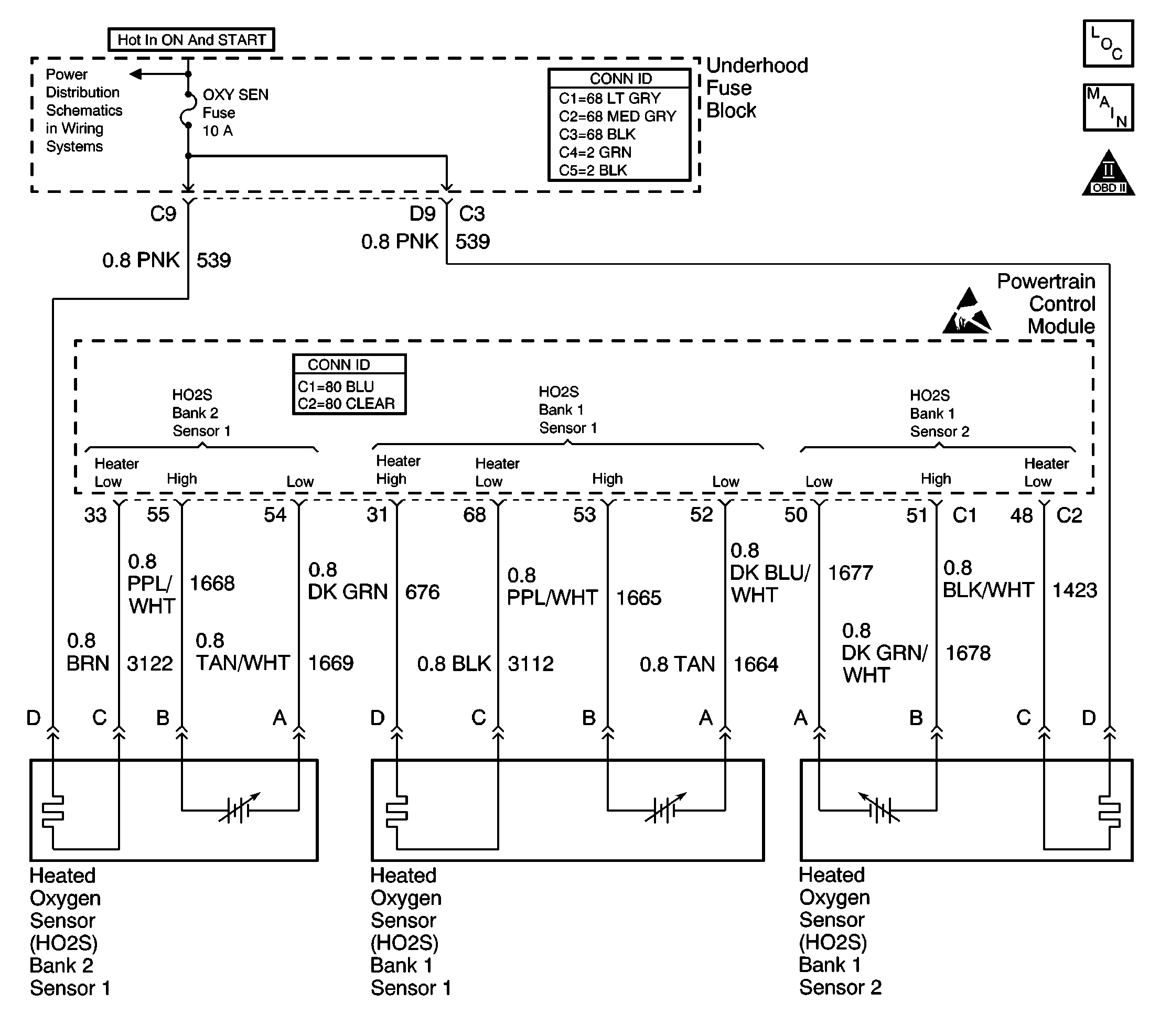
Circuit Description
The HO2S is a sensor used to detect oxygen-content in the exhaust. The PCM supplies the sensor with a signal circuit and a ground circuit. The PCM supplies a bias voltage between the circuits. The sensor varies the voltage based on the oxygen content in the exhaust. When the exhaust stream is lean (more oxygen), the sensor produces a low voltage signal. When the exhaust stream is rich (less oxygen), the sensor produces a high voltage signal.
The PCM continuously monitors the heated oxygen sensor (HO2S) signal for a calibrated period of time. During the monitoring period, the PCM counts the number of times that a rich to lean and lean to rich response occurs. Then, the PCM adds the amount of time it took to complete all transitions. The PCM detects a rich to lean transition when the HO2S voltage changes from more than 600 mV to less than 300 mV. The PCM detects a lean to rich transition when the HO2S voltage changes from less than 300 mV to more than 600 mV. The PCM uses the data to determine an average time for each transition. If the PCM determines that the average response time is too slow for HO2S bank 1 sensor 1, DTC P0133 will set.
Conditions for Running the DTC
| • | MAF, TP, EVAP, IAT, MAP, ECT, HO2S, AIR, (if equipped), misfire, or injector DTCs are not set. |
| • | DTC P0135 or DTC P1133 not set |
| • | EGR flow diagnostic inactive |
| • | AIR diagnostic test inactive |
| • | Catalyst diagnostic test inactive |
| • | Closed loop fuel enabled |
| • | System voltage between 9 and 18 volts |
| • | Engine running for more than 202 seconds |
| • | Engine coolant temperature more than 75°C (167°F) |
| • | Engine speed between 1200 and 2800 RPM |
| • | MAF between 15 and 35 g/s |
| • | TP more than 3 percent |
| • | Transmission not in Park, Reverse or Neutral |
| • | The above conditions must be met for 3.0 seconds. |
Conditions for Setting the DTC
| • | HO2S bank 1 sensor 1 lean to rich average transition response time during the sample period was longer than 200 milliseconds. |
| OR |
| • | HO2S bank 1 sensor 1 rich to lean average transition response time during the sample period was longer than 200 milliseconds. |
| • | HO2S voltage between 325 mV and 625mV. |
Action Taken When the DTC Sets
| • | The PCM illuminates the malfunction indicator lamp (MIL) during the second consecutive trip in which the diagnostic test runs and fails. |
| • | The PCM stores the conditions present when the DTC set as Freeze Frame/Failure Records data. |
Conditions for Clearing the MIL/DTC
| • | The PCM will turn the MIL OFF after the third consecutive trip in which the diagnostic runs and passes. |
| • | The history DTC will clear after 40 consecutive warm-up cycles have occurred without a malfunction. |
| • | The DTC can be cleared by using the scan tool Clear DTC Information function. |
Diagnostic Aids
Notice: Do not solder heated oxygen sensor wires. Soldering the wires will result in the loss of the air reference to the sensor. Refer to Engine Electrical for proper wire and connection repair techniques.
Check for the following conditions:
| • | Inspect harness connectors for backed out terminals, improper mating, broken locks, improperly formed or damaged terminals, and poor terminal to wire connection. Refer to Wiring Repairs in Wiring Systems. |
| • | Inspect the wiring harness for damage. If the harness appears to be OK, observe the scan tool while moving connectors and wiring harnesses related to HO2S bank 1 sensor 1 sensor. A change in the display will indicate the location of the malfunction. Refer to Wiring Repairs in Wiring Systems. |
| • | For intermittent conditions, refer to Symptoms . |
Test Description
The numbers below refer to the step numbers on the diagnostic table:
-
Verifies that the malfunction is currently present the average rich/lean and lean/rich transition times. With the ignition turned ON, the scan tool indicates the results of the last test for this diagnostic. The test conditions must be met in order for the scan tool to update the results of the test for this ignition cycle.
-
HO2S transition time, ratio, and switching DTCs set for multiple sensors indicate probable contamination. Before replacing the sensors, isolate and correct the source of the contamination to avoid damaging the replacement sensors.
Step | Action | Values | Yes | No | ||||||||
|---|---|---|---|---|---|---|---|---|---|---|---|---|
1 | Did you perform the Powertrain On Board Diagnostic (OBD) System Check? | -- | ||||||||||
|
Important: If any DTCs are set, except P1134, refer to those DTCs before proceeding with this diagnostic table. Refer to Diagnostic Trouble Code (DTC) List/Type to diagnose the applicable DTC.
Does the scan tool indicate DTC P0133 failed last test? | -- | Go to Diagnostic Aids | ||||||||||
Does the scan tool also indicate DTC P1134 failed last test? | -- | |||||||||||
4 |
Did you find and correct the condition? | -- | ||||||||||
5 |
Did you find and correct the condition? | -- | ||||||||||
6 |
Notice: Correct the source of the oxygen sensor contamination before replacing
the sensor in order to prevent future contamination. Typical contamination
sources include the following:
Replace the bank 1 heated oxygen sensor. Refer to Heated Oxygen Sensor Replacement - Bank 1 Sensor 1 . Is the action complete? | -- | -- | |||||||||
7 |
Does the scan tool indicate DTC P0133 failed this ignition? | -- | System OK |
